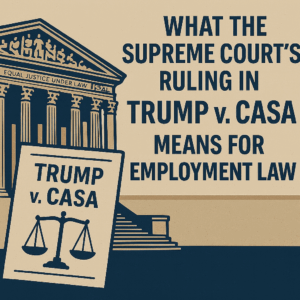The Supreme Court’s June 27, 2025, decision in Trump v. CASA, Inc. (2025 WL 1773631) has shaken the foundation of federal district court injunction power, particularly universal or nationwide injunctions that halt enforcement of laws and regulations far beyond the plaintiffs bringing suit. For employment law practitioners, this development could have sweeping implications, particularl y regarding executive orders, federal agency rules, and judicial actions affecting wage and hour policies, independent contractor classifications, non-compete agreements, and even immigration-related employment practices.
y regarding executive orders, federal agency rules, and judicial actions affecting wage and hour policies, independent contractor classifications, non-compete agreements, and even immigration-related employment practices.
In Trump v. CASA, the Court ruled that universal injunctions “likely exceed” the authority of federal district courts under the Judiciary Act of 1789, finding that equitable relief must be narrowly tailored to only the specific plaintiffs in the case. While the Court stopped short of a categorical ban, the strong language of the decision signals a major shift away from the broad injunctive powers district courts have exercised over the last decade. The ruling questions the continued validity of many nationwide injunctions that have not been appealed or overturned, and it introduces new complexities for employers navigating a web of federal and state regulatory regimes.
The Rise and Repercussions of Universal Injunctions
Universal injunctions (judicial orders that block a law or regulation on a national level) have become more common in recent years, particularly in politically charged contexts. During the last three administrations, district courts have used universal injunctions to halt enforcement of contested executive orders and regulatory actions. For instance, federal judges halted rules affecting overtime eligibility, DACA, and Title VII interpretations, applying their orders nationally despite the lawsuits being brought by only one or a handful of plaintiffs.
While these orders were often applauded for providing immediate and uniform relief, critics argue they usurp the legislative process and judicial hierarchy. The majority opinion in Trump v. CASA emphasized that federal courts must not exceed their Article III jurisdiction, which is limited to resolving the actual cases and controversies brought before them. The ruling suggests that a district court’s equitable power does not extend to issuing sweeping national directives affecting individuals and entities who are not parties to the case.
Employment Law in the Crosshairs
The practical implications for labor and employment laws are significant. Several key employment regulations, including those related to minimum wage increases, joint employer definitions, independent contractor rules, and limitations on non-compete clauses, have been challenged in federal courts. Often, these challenges have resulted in national injunctions, pausing nationwide implementation.
With Trump v. CASA calling those injunctions into question, employers may find themselves operating under different rules depending on geography and jurisdiction. This could undermine compliance consistency, particularly for companies operating in multiple states. Moreover, individuals who previously relied on others’ litigation to obtain relief may now need to actively engage the legal system to preserve their rights.
For example, if a federal court in California blocks a Department of Labor rule applying a new independent contractor test, the ruling will now be limited to the plaintiff or plaintiffs in that case rather than all employers nationwide..
Increased Legal Uncertainty
Another key consequence of this decision is the increased legal uncertainty for both employers and employees. The lack of uniformity could create a patchwork regulatory landscape, where compliance depends on the outcome of local litigation. Federal agencies may also respond by issuing guidance tailored to narrower judicial interpretations, rather than broad national policies.
For employers, this could mean adjusting HR policies more frequently or implementing state-specific protocols in areas like wage classification, scheduling, or leave entitlements. For employees, the path to consistent legal protections becomes less straightforward and more dependent on geographic location and active litigation.
Strategic Considerations for Employers
In a post-CASA world, it’s critical to proactively plan for litigation. Multi-state employers need to closely monitor legal developments in each state where they operate. Understanding which rules are enjoined can help avoid inadvertent violations and costly penalties.
Moreover, employers should consider engaging legal counsel when federal rules change, even if an injunction appears to block enforcement of those rules. A universal injunction may no longer apply universally, and relying on outdated assumptions about the rule’s validity can result in legal exposure.
Employers should also be aware that litigation strategy may shift. Trade associations or employer coalitions may seek to bring suit in multiple jurisdictions to obtain tailored relief. Meanwhile, regulatory agencies may pursue narrower enforcement efforts to avoid triggering large-scale litigation.
Looking Ahead
The Supreme Court’s decision in Trump v. CASA is already reshaping how federal courts, agencies, and litigants approach nationwide policy disputes. For employment law, it marks a return to case-specific adjudication, and an increase in rule-challenging class actions.. The decision also increases the compliance burden on employers, who must now pay even closer attention to where and how federal rules are challenged and enforced.
In this dynamic legal environment, staying ahead of developments is crucial. If your business is facing regulatory uncertainty or compliance challenges stemming from federal rule changes, Hoyer Law Group can help. Our experienced employment law attorneys can advise on how shifting legal standards affect your workforce policies. Contact us today to schedule a consultation.


